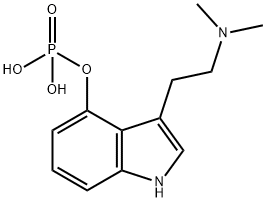ChemicalBook > CAS DataBase List > psilocybine
psilocybine
psilocybine
- CAS No.520-52-5
- Chemical Name:psilocybine
- CBNumber:CB5932766
- Molecular Formula:C12H17N2O4P
- Formula Weight:284.25
- MOL File:520-52-5.mol
psilocybine Property
- Melting point 220-2280C
- Boiling point 523.4±60.0 °C(Predicted)
- Density 1.409±0.06 g/cm3(Predicted)
- Flash point 2℃
- storage temp. −20°C
- form solid
- pka 1.25±0.30(Predicted)
- FDA UNII 2RV7212BP0
Safety
- RIDADR :1544
- WGK Germany :1
- RTECS :NM3150000
- HazardClass :6.1(b)
- PackingGroup :III
- Hazardous Substances Data :520-52-5(Hazardous Substances Data)
- Toxicity :LD50 in mice, rats, rabbits (mg/kg): 285, 280, 12.5 i.v. (Usdin, Efron)
-
NFPA 704:
3 2 0
-
Symbol(GHS)



- Signal wordDanger
- Hazard statements H225-H301+H311+H331-H370
- Precautionary statements P210-P260-P280-P301+P310-P311
psilocybine Chemical Properties,Usage,Production
- Description The intentional ingestion of hallucinogenic mushrooms by Mesoamerican natives dates back centuries. Early European explorers documented the Mayan and Aztec symbolism depicting the use of mushroom during spiritual ceremonies. Albert Hofmann first synthesized lysergic acid diethylamide (LSD) from psilocybin extracted from mushrooms. During the 1960s and 1970s, researchers conducted experiments on the utility of psilocybin for psychotherapy before drug laws curbed its use. Psilocybin is described as an entheogen, a substance used to raise spiritual consciousness. Today most countries have outlawed psilocybin possession; however, widespread illicit use continues.
- Chemical Properties Crystallin Solid
- Uses The most common use of this mushroom is to induce recreational hallucinations. Some Native American groups continue to employ psilocybin-containing mushroom species in official ceremonies. The adjunctive use of psilocybin for mainstream psychotherapy has been discontinued. Hallucinogenic mushrooms are generally considered a low-harm drug of abuse.
- Uses The major of two hallucinogenic components of Teonanacatl, the sacred mushroom of Mexico, the other component being psilocin. Psychomimetic. Controlled substance (hallucinogen).
- Definition An indole derivative. An alkaloid from certain mushrooms; hallucinogenic drug.
- Safety Profile Poison by intravenous route. Moderately toxic by intraperitoneal route. Human systemic effects by ingestion and intraperitoneal routes: euphoria, hallucinations, toxic psychosis, muscle weakness, nausea or vomiting, visual field changes. Mutation data reported. When heated to decomposition it emits very toxic fumes of NOx and POx.
psilocybine Preparation Products And Raw materials
Raw materials
Preparation Products
Global(0)Suppliers
520-52-5, psilocybineRelated Search:
- Phosphorylating and Phosphitylating Agents
- Pharmaceuticals
- Intermediates & Fine Chemicals
- Indole Derivatives
- C12H17N2O4P
- 520-52-5
- GMP Psilocybin
- Psilocybin Analytical Reference Standard
- Psilocybin (CRM)
- QVDSEJDULKLHCG-UHFFFAOYSA-N
- Psilocybin (exempt preparation)
- Psilocybin solution
- Psilocybin (1.0mg/ml in Methanol)
- PSILOCYBIN USP/EP/BP
- Psilocybin (1.0 mg/mL in 1:1 Acetonitrile:Water)
- Psilocine Phosphate
- O-Phosphoryl-4-hydroxy-N,N-dimethyltryptamine
- Indocybin
- Cy 39
- 4-Phosphoryl-N,N-dimethyltryptamine
- 3-[2-(Dimethylamino)ethyl]-1H-indol-4-ol 4-Dihydrogen Phosphate Ester
- INDOL-4-OL,3-(2-DIMETHYLAMINO)ETHYL)-DIHYDROGENPHOSPHATE
- 1H-Indol-4-ol, 3-[2-(diMethylaMino)ethyl]-, 4-(dihydrogen phosphate)
- [3-(2-dimethylaminoethyl)-1H-indol-4-yl] dihydrogen phosphate
- 3-(2-Dimethylaminoethyl)-1H-indol-4-ol dihydrogen phosphate
- 3-[2-(Dimethylamino)ethyl]-1H-indol-4-yl phosphate
